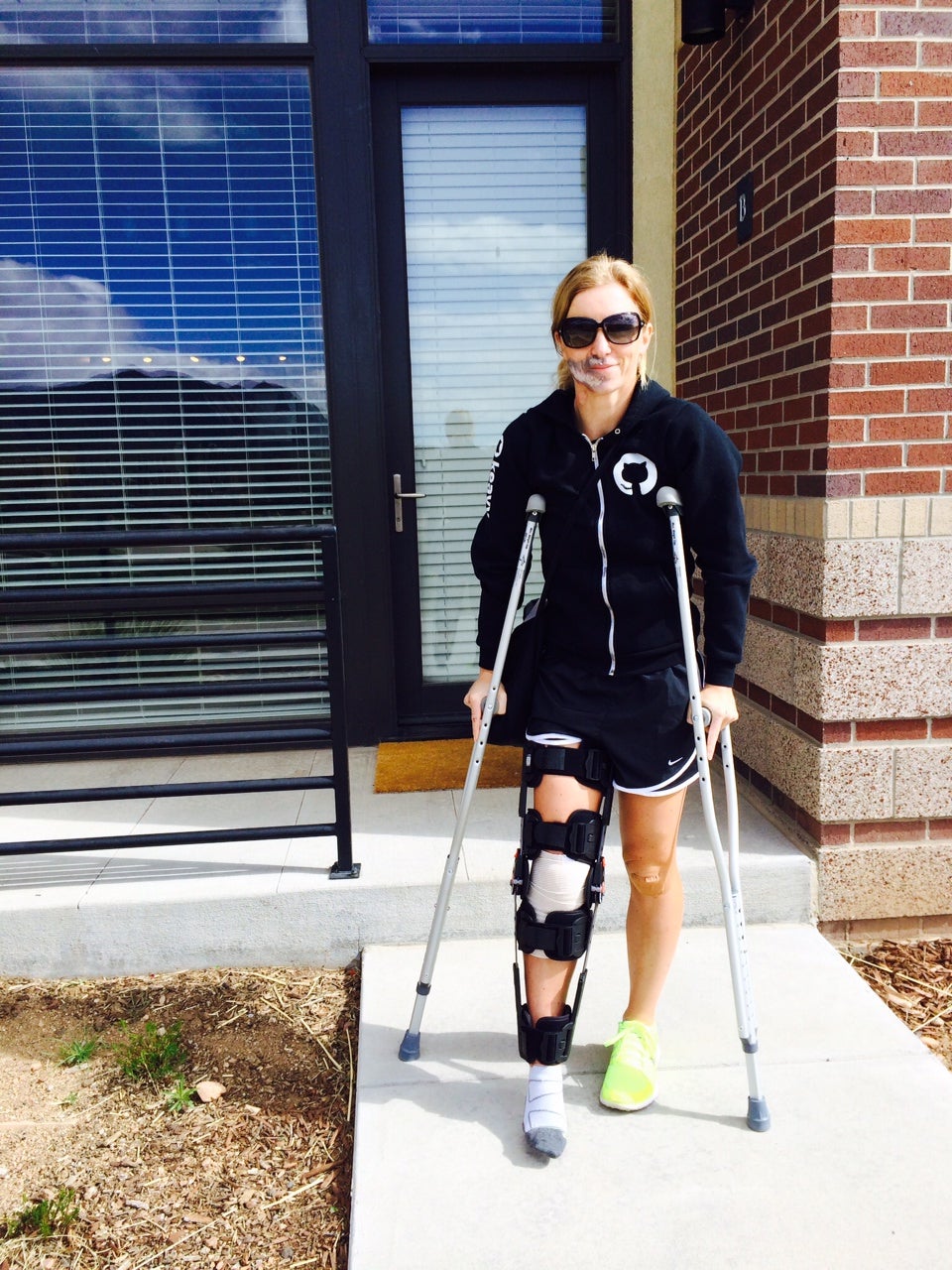Dispatch: Safe Strategies To Share The Road

Keavy hobbling off to the orthopedic specialist.
Keavy McMinn, a good friend of mine and a Boulder-based triathlete who I profiled last year, was involved in a serious cycling accident last week, wherein a car turned in front of her as she descended a hill. She’s battered and bruised and has a broken leg, but she’ll ultimately heal. Keavy’s lucky in a sense–her injuries could have been far worse. But the accident has surely derailed her spring and summer fitness plans (she was slated to race both Ironman 70.3 St. George and Challenge Roth). Sadly, Keavy’s story is just one in a growing number of accident reports that have made recent headlines. Sure, there’s a risk anytime we board our bikes, but we should be able to safely share the road and enjoy the great outdoors while getting our beloved exercise. And while the risks in cycling are not enough to deter most of us from pursuing our passion, there are a number of things we can do to enhance our safety on the bike, as well as important tips for what to do in case we (or our riding partners) are involved in an accident. Combining common sense with some of the after-the-fact information that Keavy gleaned from the law enforcement officials and the attorney investigating her accident, she and I compiled the following collection of important cycling safety and accident awareness tips.
A Checklist For Every Ride
- Wear your helmet every time you ride. Cars don’t differentiate whether you’re on a long training ride or simply spinning down the street to the coffee shop. Point being, protect your head. Accidents can and do happen anywhere, anytime.
- Wear a Road ID or other personal identification device so that first responders can easily access your medical information and emergency contacts.
- Carry your insurance card, along with your photo ID. Any emergency room is required to treat you in case of an accident, however if you need to be transferred to another facility, it’s possible that you can be refused admittance without confirmation of your insurance plan.
- Program an ICE (In Case of Emergency) contact in your phone.
- Wear bright, contrasting colors during the day. Wear light colors and use high-visibility (front and rear) and blinking (rear) lights when riding at night.
- Wear sunglasses–even on cloudy days with clear lenses. They provide eye protection from insects and road debris, and can also protect your eyes in case of a crash.
- If you ride solo, always let someone know when you head out, your intended route and your ETA back home.
- Keavy’s attorney, Fred Coogan, has represented many cyclists over the years. Mr. Coogan stresses that every cyclist should maintain “Uninsured/Underinsured Motorist” coverage as well as “Personal Injury Protection” coverage on their automobile insurance policy. This coverage will help an injured cyclist in the event the driver of the car does not have enough insurance and may also compensate the cyclist for expenses and lost income that are not covered under health insurance.
RELATED: Bike Safer With Road ID’s New App
Tips To Say Safe On The Bike
- Ride defensively–anticipate accidents in order to avoid them. Drivers may have blind spots or be distracted. Protect yourself as much as possible by staying alert to those around you.
- Never assume a car will stop or yield to you. Be safe rather than bold.
- Unless you’re riding on a traffic-free road, ride single file.
- Follow motor vehicle driving laws. If you want to share the road, it’s only fair that you share the rules (plus, it’s the law).
- In the battle of car vs. bike, the car will always win. The majority of drivers are considerate and conscientious. But ride often enough and eventually you’ll experience a driver’s anti-cyclist road rage. Don’t yell at a driver that wrongs you–don’t make rude hand gestures toward them and certainly don’t bang on the car. Remember that you’re in a vulnerable position, and that an angry driver is not someone you want to rumble with. Do your best to diffuse the situation or remove yourself from it as quickly as possible. Do memorize the car’s license plate and make a police report if you wish to follow up with appropriate action.
RELATED: Bouncing Back From A Bike Crash
What To Do If An Accident Happens
Note: Obviously your ability to accomplish some of these items will be determined by your condition post-crash–but these are important points to keep in mind whether you or one of your riding partners are involved in an accident, or if you come upon the scene of a downed cyclist.
- Dial 911.
- If you are injured, stay still and wait for first responders to assist you. People often think their injuries are not serious, when in fact they might be.
- If you are involved in a collision with a car, treat it like you would a motor vehicle accident. Even if your injuries are minor, make sure to exchange contact and insurance information with the driver and file a police report. An injury that seems minor may be worse than initially assessed, and damage to your bike or other property may not be immediately apparent.
- If the driver leaves the scene, try to get the car’s license plate number and a description of the vehicle.
- Make note of any details that might assist an investigation, if one is necessary. Information such as location, time and date, weather conditions and cycling computer data may be helpful, in addition to photos of the scene and of any injuries and property damage sustained.